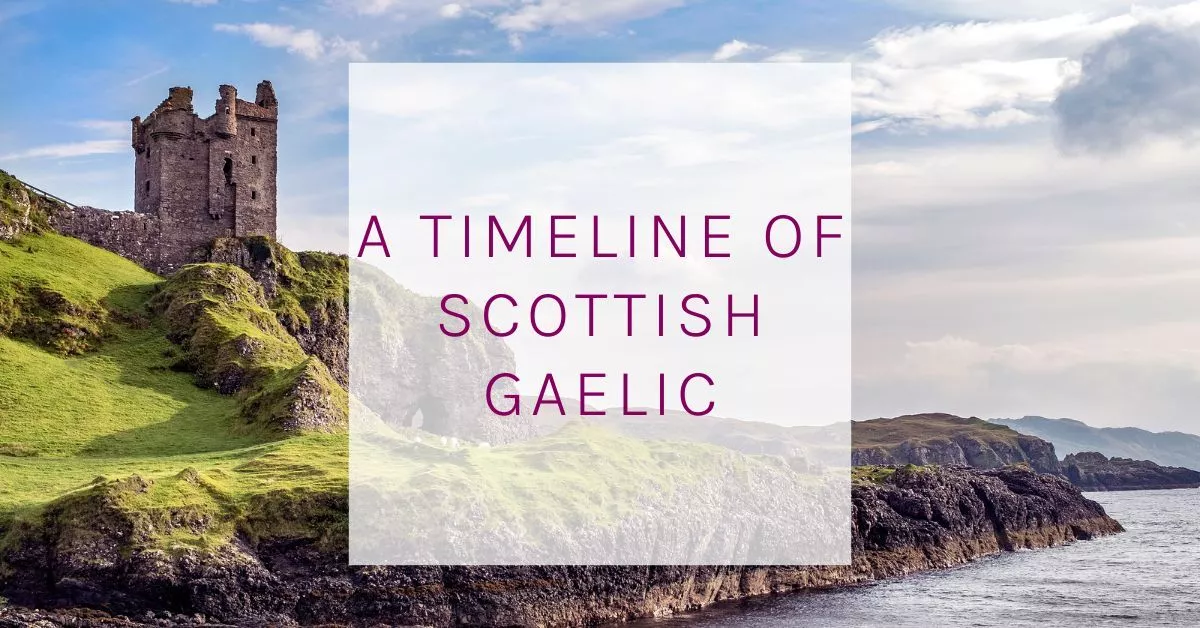
For World Gaelic Week 2023, we’re diving into an exploration of the Scottish Gaelic language. In everything we do at Maccessori, we are inspired and influenced by Scotland. From the Scottish landscapes, culture, traditions, colours and even language, everything we create comes from Scotland somewhere. So on World Gaelic Week, let us teach you a little about Scottish Gaelic.
Scottish Gaelic is a distinct language with a rich and ancient history. From its early origins to its current use in Scotland today, explore the key moments that have defined Scottish Gaelic’s culture and evolution over time.
Scots Gaelic stems from the Irish language. It was introduced in Scotland around AD 500 (displacing an early Celtic language), and a distinct dialect of Gaelic was developed by the 13th Century.
Scotland experienced political unification around the 11th Century. This led to new and innovative ways of writing in Scottish Gaelic. During this time, laws were written using Old Irish which helped to standardise spelling conventions for Scottish Gaelic writers. Various Gaelic poets then began to compose verses which served as archives of key events within Scotland’s history and culture. These poems also helped keep Scottish Gaelic alive!
Medieval researchers and writers helped to keep Scottish Gaelic alive in an ever-changing landscape. Poets wrote about major events and key developments within Scotland’s history. These poets highlighted not just political conquests but also daily life, people and heroes of Scotland ensconced in folklore. Such rich sources contribute to a remarkable body of work which still influences Scotland today.
During the 18th century, clan culture and Gaelic-speaking communities surged across Scotland as a resurgence of loyalty and identity to Scots. The restructuring of clan boundaries led to groups reclaiming ancestral lands while re-instilling Gaelic language, music and customs in key economic centres such as fishing, weaving and building trades. At this time, gaels even began colonizing areas they previously did not inhabit and shared their rich culture with a variety of Clans. While some clans adopted English or Lowland Scots as their language of choice, many clung to their Scottish Gaelic roots allowing it to thrive sporadically across the country.
In the spirit of early Scottish Gaelic advocates, there are a number of organisations dedicated to guarding and protecting the legacy of Scottish Gaelic. Today, there is an ever-growing support network around Scotland in both urban areas and rural communities. From linguistic organizations like Bòrd na Gàidhlig and Comunn na Gàidhlig working to promote Gaelic language use, to festivals celebrating traditional music, art, dance and more; each of them helping to keep Gaelic alive today.
| Cookie | Duration | Description |
|---|---|---|
| cookielawinfo-checkbox-analytics | 11 months | This cookie is set by GDPR Cookie Consent plugin. The cookie is used to store the user consent for the cookies in the category "Analytics". |
| cookielawinfo-checkbox-functional | 11 months | The cookie is set by GDPR cookie consent to record the user consent for the cookies in the category "Functional". |
| cookielawinfo-checkbox-necessary | 11 months | This cookie is set by GDPR Cookie Consent plugin. The cookies is used to store the user consent for the cookies in the category "Necessary". |
| cookielawinfo-checkbox-others | 11 months | This cookie is set by GDPR Cookie Consent plugin. The cookie is used to store the user consent for the cookies in the category "Other. |
| cookielawinfo-checkbox-performance | 11 months | This cookie is set by GDPR Cookie Consent plugin. The cookie is used to store the user consent for the cookies in the category "Performance". |
| viewed_cookie_policy | 11 months | The cookie is set by the GDPR Cookie Consent plugin and is used to store whether or not user has consented to the use of cookies. It does not store any personal data. |